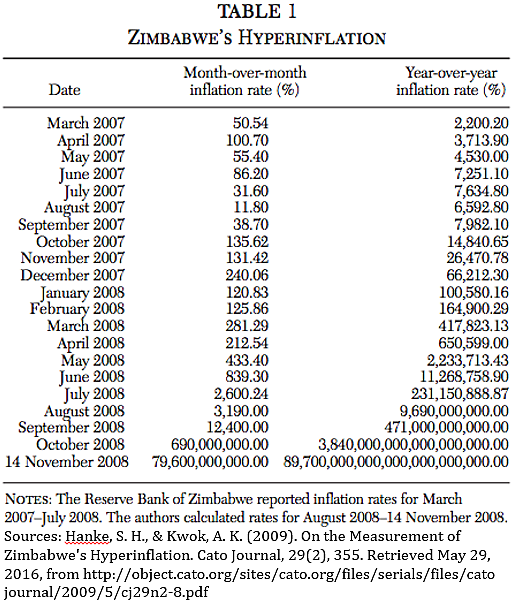Most press reports about Zimbabwe’s fantastic hyperinflation are off the mark – way off the mark. Even our most trusted news sources fail to get the facts right. This confirms the “95 Percent Rule”: 95 percent of what you read in the financial press is either wrong or irrelevant.
When it comes to the reportage about hyperinflation, there are no excuses. All 56 of the world’s hyperinflations have been carefully documented in “World Hyperinflations”. This record is available in the Routledge Handbook of Major Economic Events in Economic History (2013) and has been available online since 2012 at the Cato Institute.
The International Monetary Fund (IMF) is the main culprit, a prominent source of the faulty data. EvenThe Economist magazine has fallen into the trap of uncritically accepting figures pumped out by the IMF and further propagating them. It’s no wonder that there is a massive gap between the public’s perception and economic reality. A gap that, ironically, The Economist reports on this week.
The Economist’s most recent infraction on Zimbabwe’s hyperinflation appeared in the May 2016 issue. The magazine claimed that the hyperinflation peaked at an annual rate of 500 billion percent. Where did this figure originate? You guessed it. That figure is buried in the IMF’s 2009 Article IV Consultation Staff Report on Zimbabwe.
In reality, Zimbabwe’s annual inflation rate in September 2008 was 471 billion percent, not 500 billion percent. More importantly, Zimbabwe’s hyperinflation peaked in November, not September. It was then that Zimbabwe recorded the second-highest hyperinflation in history: a whopping 89.7 sextillion percent. This is 179 billion times greater than the IMF’s figure.
That said, the IMF did attempt to cover its backside from questions about its hyperinflation guestimate. 2009 Article IV Staff Report on Zimbabwe states clearly that “data have serious shortcomings that significantly hamper surveillance due to capacity constraints.” Despite the red flag, The Economistcontinues to blindly propagate a figure that is neither reliable nor replicable. I stress the word “continues”.
It turns out that The Economist is a serial propagator of inaccurate IMF figures. The magazine has cited IMF’s incorrect figure of 500 billion percent before, in June 2009 and October 2015.
For accurate estimates of Zimbabwe’s fantastic hyperinflation that are used in the professional literature – estimates that are reliable and replicable – the IMF and the financial press corps should take a look at the following table from “On the Measurement of Zimbabwe’s Hyperinflation”, which was published in The Cato Journal, (2009):

